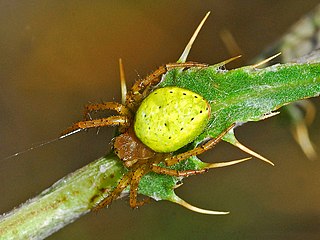Benoy Krishna Tikader (1928–1994) was an Indian arachnologist and zoologist and a leading expert on Indian spiders in his time. He worked in the Zoological Survey of India and published the Handbook of Indian Spiders in 1987. The book describes 40 families and 1066 species of India, many of which were described by Tikader himself. The handbook is a guide to all arachnids including scorpions, and not just spiders. He was also a popular scientific author in his native language of Bengali, and was the author of Banglar Makorsha for the layman.

Neoscona, known as spotted orb-weavers and barn spiders, is a genus of orb-weaver spiders (Araneidae) first described by Eugène Simon in 1895 to separate these from other araneids in the now obsolete genus Epeira. The name Neoscona was derived from the Greek νέω, meaning "spin", and σχοῖνος, meaning "reed". They have a mostly pantropical distribution and one species, Neoscona adianta, has a palearctic distribution. The genus has more than 100 species, eight of which can be found in the United States and Canada as of April 2019.

Spider fighting or spider derby is a sport involving spiders that occurs in different forms in several areas of the world. Among them are the Philippines, Japan, Singapore and Malaysia. The fights that occur in the Philippines and in Japan are staged between females of various species of web weavers. Female spiders will kill a rival if the loser does not quickly flee or receive the aid of a human handler. The contests that are staged in Malaysia and Singapore are fights between male jumping spiders. The males fight only for dominance, and ordinarily the loser will flee, though sometimes they will lose a leg in the fight.

Neoscona adianta is a species of spider belonging to the family Araneidae. It occurs in North Africa and Europe to Central Asia.

Neoscona punctigera is a widespread species of orb-weaver spider found from Japan to mainland Asia, Australia and several Western Indian Ocean islands.

Neoscona crucifera is an orb-weaver spider in the family Araneidae. It is found in the United States from Maine to Florida in the east, to Minnesota in the Midwest, to Arizona in the southwest, southern California coastal communities and in Mexico. Its common names include Hentz orbweaver, spotted orbweaver, and barn spider. The name "barn spider" is also commonly used for a different spider, Araneus cavaticus.

Neoscona domiciliorum, commonly known as the spotted orbweaver or redfemured spotted orbweaver, is a spider in the family Araneidae. The specific epithet domiciliorum means "of dwellings" in Latin and refers to the fact that this species is often found living on buildings. Their bites are not known to cause serious harm in humans.

Neoscona arabesca is a common orb-weaver spider found throughout North America. Often called the arabesque orbweaver, after the cryptic, brightly colored, swirling markings on its prominent abdomen, this spider can be found in fields, forests, gardens, and on human structures. Neoscona species are among the most common and abundant orb weavers and are found on all continents. Females range in size from 5–7 mm (0.20–0.28 in) and males 5–6 mm (0.20–0.24 in).

Quaranjavirus is a genus of enveloped RNA viruses, one of seven genera in the virus family Orthomyxoviridae. The genome is single-stranded, negative-sense segmented RNA, generally with six segments. The genus contains two species: Johnston Atoll virus and Quaranfil virus; it has been proposed to contain species or strains including Cygnet River virus, Lake Chad virus, Tyulek virus and Wellfleet Bay virus. Quaranjaviruses predominantly infect arthropods and birds; As of March 2015, Quaranfil quaranjavirus is the only member of the genus to have been shown to infect humans. The Quaranfil and Johnston Atoll viruses are transmitted between vertebrates by ticks, resembling members of Thogotovirus, another genus of Orthomyxoviridae.

Neoscona oaxacensis, known as western spotted orbweaver and zig-zag spider, is a species of spider in the family Araneidae. It is distributed in the Americas, from Kansas and California south to Venezuela and Peru, including the Galápagos Islands.

Neoscona theisi is a species of spider in the family Araneidae. Spiders in the genus Neoscona have a mostly pantropical distribution.
Neoscona utahana is a species of orb weaver in the spider family Araneidae. It is found in the United States and Mexico.

Neoscona pratensis is a species of orb weaver in the spider family Araneidae. It is found in the United States and Canada.

Neoscona byzanthina is an orb-weaver spider.

Leucauge decorata, the decorative silver orb spider, is one of the long-jawed orb weaver spiders. A medium to large sized orb weaving spider, with a body length up to 12 mm long (female). Male to 6 mm. This species has a "point" to the end of the abdomen.

Araniella opisthographa is a species of orb weaver in the spider family Araneidae.

Wilhelmus Egbertus Antonius Janssen, better known as Father Chrysanthus OFMCap, was a Dutch priest and biology teacher. He was known for his studies in arachnology. Initially he was concerned with the spiders of the Netherlands but he became a specialist on New Guinea spiders. Two spider species were named in his honor following his death.
Neoscona chrysanthusi is a species of orb-weaver spider native to Bhutan, India and Pakistan. The specific epithet honors the Dutch arachnologist Father Chrysanthus "in token of high regard which the present authors have for him."














